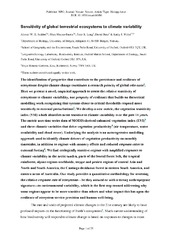| dc.description.abstract | The identification of properties that contribute to the persistence and resilience of ecosystems despite climate change constitutes a research priority of global relevance1. Here we present a novel, empirical approach to assess the relative sensitivity of ecosystems to climate variability, one property of resilience that builds on theoretical modelling work recognizing that systems closer to critical thresholds respond more sensitively to external perturbations2. We develop a new metric, the vegetation sensitivity index, that identifies areas sensitive to climate variability over the past 14 years. The metric uses time series data derived from the moderate-resolution imaging spectroradiometer (MODIS) enhanced vegetation index3, and three climatic variables that drive vegetation productivity4 (air temperature, water availability and cloud cover). Underlying the analysis is an autoregressive modelling approach used to identify climate drivers of vegetation productivity on monthly timescales, in addition to regions with memory effects and reduced response rates to external forcing5. We find ecologically sensitive regions with amplified responses to climate variability in the Arctic tundra, parts of the boreal forest belt, the tropical rainforest, alpine regions worldwide, steppe and prairie regions of central Asia and North and South America, the Caatinga deciduous forest in eastern South America, and eastern areas of Australia. Our study provides a quantitative methodology for assessing the relative response rate of ecosystems—be they natural or with a strong anthropogenic signature—to environmental variability, which is the first step towards addressing why some regions appear to be more sensitive than others, and what impact this has on the resilience of ecosystem service provision and human well-being. | en_US |
